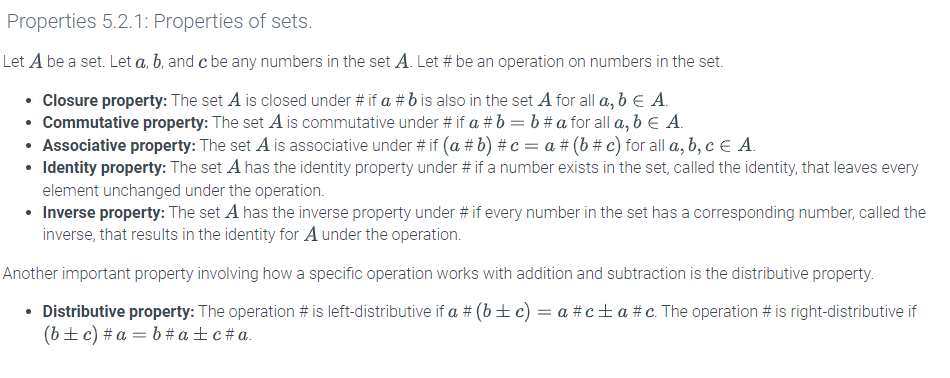Explain each step, excluding those that are labeled as “no justification needed.” For each step, identify the property of the real numbers being used and explain how that property is being applied. I attached a picture of the step I need help with, along with the properties.
Explain each step, excluding those that are labeled as “no justification needed.” For each step, identify the property of the real numbers being used and explain how that property is being applied. I attached a picture of the step I need help with, along with the properties.
Algebra: Structure And Method, Book 1
(REV)00th Edition
ISBN:9780395977224
Author:Richard G. Brown, Mary P. Dolciani, Robert H. Sorgenfrey, William L. Cole
Publisher:Richard G. Brown, Mary P. Dolciani, Robert H. Sorgenfrey, William L. Cole
Chapter4: Polynomials
Section4.5: Multiplying Polynomials By Monimials
Problem 23WE
Related questions
Question
Explain each step, excluding those that are labeled as “no justification needed.” For each step, identify the property of the real numbers being used and explain how that property is being applied.
I attached a picture of the step I need help with, along with the properties.

Transcribed Image Text:=-3x +42 + (-60 +4x)
=-3x + (42 + (-60)) + 4x

Transcribed Image Text:Properties 5.2.1: Properties of sets.
Let A be a set. Let a, b, and c be any numbers in the set A. Let # be an operation on numbers in the set.
• Closure property: The set A is closed under # if a #b is also in the set A for all a, b € A.
• Commutative property: The set A is commutative under # if a # b = b #a for all a, b € A.
• Associative property: The set A is associative under # if (a #b) # c = a # (b # c) for all a, b, c = A.
• Identity property: The set A has the identity property under # if a number exists in the set, called the identity, that leaves every
element unchanged under the operation.
• Inverse property: The set A has the inverse property under # if every number in the set has a corresponding number, called the
inverse, that results in the identity for A under the operation.
Another important property involving how a specific operation works with addition and subtraction is the distributive property.
• Distributive property: The operation # is left-distributive if a # (b±c) = a #c±a #c. The operation # is right-distributive if
(b + c) #a= b #a±c #a.
Expert Solution
This question has been solved!
Explore an expertly crafted, step-by-step solution for a thorough understanding of key concepts.
This is a popular solution!
Trending now
This is a popular solution!
Step by step
Solved in 3 steps with 2 images

Recommended textbooks for you

Algebra: Structure And Method, Book 1
Algebra
ISBN:
9780395977224
Author:
Richard G. Brown, Mary P. Dolciani, Robert H. Sorgenfrey, William L. Cole
Publisher:
McDougal Littell


Elementary Algebra
Algebra
ISBN:
9780998625713
Author:
Lynn Marecek, MaryAnne Anthony-Smith
Publisher:
OpenStax - Rice University

Algebra: Structure And Method, Book 1
Algebra
ISBN:
9780395977224
Author:
Richard G. Brown, Mary P. Dolciani, Robert H. Sorgenfrey, William L. Cole
Publisher:
McDougal Littell


Elementary Algebra
Algebra
ISBN:
9780998625713
Author:
Lynn Marecek, MaryAnne Anthony-Smith
Publisher:
OpenStax - Rice University
